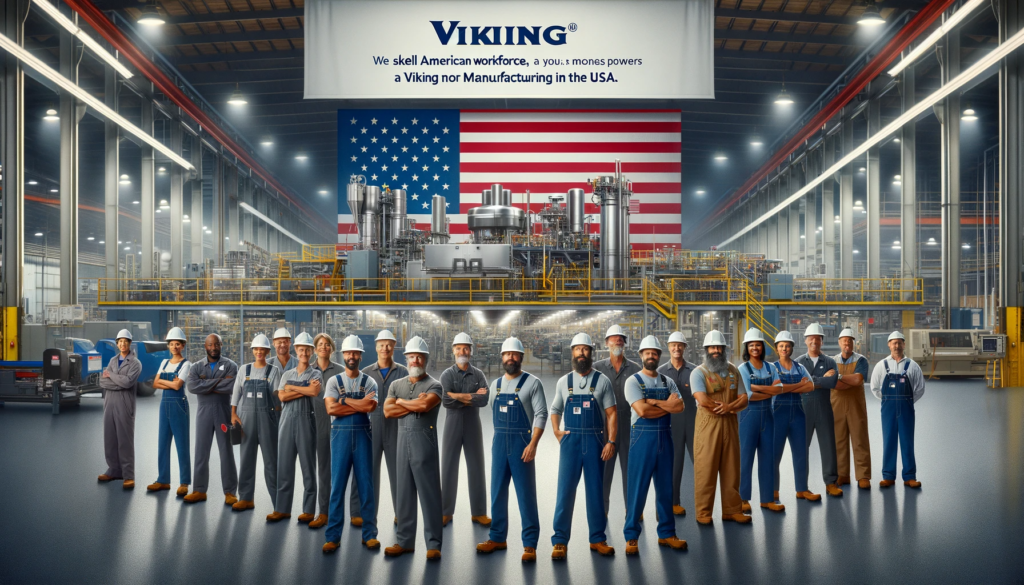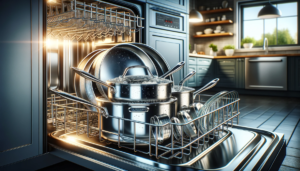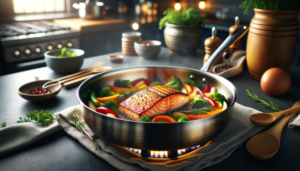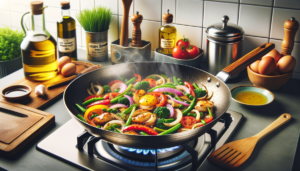With appliance brands increasingly outsourcing overseas, many wonder where leading American cookware company Viking fabricates their signature pots and pans.
Through its state-of-the-art Greenwood, Mississippi headquarters factory, Viking preserves tradition and jobs crafting quality cookware locally in the USA.
Let’s explore Viking’s domestic manufacturing and what keeps them producing stateside.
Where Is Viking Cookware Made?

Viking cookware is made primarily at the company’s Greenwood, Mississippi headquarters factory which has produced the majority of Viking pans and pots domestically in the USA since the company’s founding in 1989.
As one of the few remaining American cookware brands still manufacturing stateside, Viking sets itself apart through its commitment to quality production oversight.
We’ll explore below in more detail Viking’s history and decision to keep cookware fabrication based in the USA rather than outsourcing abroad.
History of Viking Cookware

Viking Range, LLC, the company behind Viking cookware, was founded in 1989 by Fred Carl Jr.
and his wife Linnea Carl in the small town of Greenwood, Mississippi.
Greenwood has a population just under 15,000 residents and is known for its rich history as a cotton port along the Yazoo River.
It was this riverside location combined with the availability of skilled local laborers that first drew the Carls to set up their company in Greenwood.
What started as a project to construct high-quality ranges to sell at local weekend art fairs and festivals soon garnered major attention from home chefs across the county.
As word spread about the superior craftsmanship, cutting-edge technology and unmatched performance of Viking ranges, demand increased rapidly beyond what the Carls ever imagined when launching their mom-and-pop operation.
This surge in popularity led the company to expand into manufacturing entire lines of kitchen products under the Viking brand name, including cookware made of the finest surgical grade stainless steel and the latest ceramic nonstick coatings.
The Viking name soon became recognized globally for exceptionally durable, versatile professional-grade cooking equipment crafted to perform flawlessly in home kitchens.
Despite massive worldwide success over three decades, Mississippi has remained central to Viking’s identity and the majority of its manufacturing operations.
Most Viking cookware continues to be skillfully constructed at the company’s original domestic factory in Greenwood which today employs over 200 residents from the local community.
Viking’s US Manufacturing Facility

A source of great pride for Viking is its sprawling 125,000 square foot manufacturing facility located right in Greenwood, Mississippi where the company first began operations in 1989.
While many successful corporations end up outsourcing manufacturing abroad as they grow, Viking has maintained a strong commitment to keeping production stateside.
The vast majority of Viking cookware continues to be expertly constructed at their highly advanced Greenwood factory which today accounts for over 200 local jobs.
Only two specialized Viking cookware lines specifically geared for the Asian market contain imported labels from partner factories in China.
However, all other Viking stock pot, pans, skillets and essential cooking accessories proudly feature a made in the USA designation signifying they were fabricated domestically by Viking’s own household names of workers.
Mississippi residents frequently coming from generations of families who have spent their lives mastering various facets of metal work take immense pride producing what they dub as some of the finest cookware in the world.
Continuous investments in cutting-edge robotic machines, polishing equipment and quality control technology allow the Greenwood facility to churn out innovatively designed products of the highest grade stainless steel and aluminum combinations that stand the test of daily use.
Local workers oversee and calibrate this machinery while lending their expertise fabricating pots and pans renowned for unparalleled heat conductivity.
Their efforts support the financial health of their own community.
Additionally, conducting business with stateside raw material suppliers and Distribution Centers reduces environmental impacts from transport.
So consumers can feel good knowing that when a Viking pan graces their stovetop, they are benefiting from an exemplary American-made product built specifically to cook and perform superbly for generations of satisfying use.
Materials and Manufacturing Process

Viking constructs all of its cookware from the highest caliber 300 series stainless steel sourced from mills within the United States.
The specific grade used is an 18/10 chromium/nickel composition steel containing 18% chromium and 10% nickel blended together to create an optimal balance of corrosion resistance with a beautiful mirror finish that is highly scratch resistant and will maintain its brilliant luster for a lifetime of use.
The company is also renowned for its innovative five-layer cookware design featuring an extra thick pure aluminum core laminated between two layers of 18/10 stainless steel.
A 5mm encapsulated aluminum core allows for superior heat conductivity and distribution so there are no hot spots while cooking.
This quintuple ply construction also eliminates warping for perfectly even cooking results whether searing meats or simmering sauces.
Added layers of stainless steel on exterior surfaces resists denting and other aesthetic damage from kitchen wear and tear.
Non stick layers applied to cooking surfaces provide easy food release properties clean up effortlessly while avoiding abrasive scrubbing requried by traditional stainless steel.
Every Viking cookware piece undergoes stringent testing and quality control checks throughout the manufacturing process at their Greenwood facility.
Skilled workers personally hand polish and inspect all pans, ensuring they meet exacting standards for optimal heat distribution.
Pans are rigorously tested by cooking test omelets on induction burners that can pinpoint any inconsistencies by exposing hot or cold spots.
If satisfactory results are not achieved, the cookware is sent back to the drawing board until all performance benchmarks are met without compromise, regardless of development costs.
This hands-on diligence demonstrates Viking’s commitment to only selling products hand-crafted to the highest reachable standards.
Quality Control and Standards

Overseeing production quality is serious business at Viking’s USA manufacturing facility.
Every cookware piece must pass through a minimum of 12 separate checkpoints and assessments performed by workers trained in meticulous inspection protocols.
All nonstick coatings are verified under fluorescent lighting for proper application with no inconsistencies in texture or appearance.
Rivets and handles are hand checked using calipers to guarantee a seamless fit with tight tolerance levels under 1 millimeter for maximum durability.
Pans and pots undergo final sustained cooking endurance tests to confirm efficient heat distribution with no cool or hot spots that could lead to uneven cooking.
Computerized sensors record minute temperature variations throughout pot and pan bodies as oils are heated to routine cooking temperatures for extended 30 minute durations.
If any issue no matter how subtle is detected at any point during the rigorous manufacturing and examination process, the cookware does not make it to market until the defect is remedied to Viking’s uncompromising standards.
The company backs this diligence with generous warranty coverage protecting against defects in workmanship and materials.
Viking will swiftly replace through its dealer network any item confirmed to exhibit premature flaws or failure resulting from a lapse somewhere in the production process.
All products are also covered by a 60-day home trial allowing for returns through authorized dealers if the consumer decides there is something unsatisfactory about the cookware’s performance in their kitchen.
These assurances give further testament to Viking’s commitment to only selling products hand-crafted to the highest reachable standards prior to being distributed from their facility nestled in America’s south.
Product Lines Made in the USA

Consumers can feel positive that when purchasing Viking cookware, they are investing in a quality American-made product crafted domestically by Mississippi workers.
An extensive portion of Viking pans and pots across all product lines contain the made in USA label signifying they were manufactured stateside at Viking’s headquarters factory utilizing locally sourced stainless steel and aluminum.
One rare exception is a small portion of Viking’s accessories such as tempered glass lids and cooking utensils which are produced internationally through a highly vetted Taiwanese factory.
However, the majority of critical components including frying pans, sauce pots, sauté pans, stock pots and skillets bearing the Viking badge are fabricated directly on US soil.
Over 85% of the Viking cookware catalog is manufactured at their domestic Greenwood facility.
It is quite noteworthy in this age of globalized manufacturing that so much of Viking cookware sold worldwide is still produced locally in the US.
But one step inside the company’s Missisipi factory with its top-of-the-line robotic presses, polishers and molding equipment makes it easy to see why Viking chooses not to outsource.
They have spare no expense investing in technology guided by generational skill to achieve maximum efficiency producing the quality users expect from the Viking name.
So when searching for their next pots and pans, consumers should feel confident that products branded with the Viking logo are backed by decades of American manufacturing prowess.
Reasons for Domestic Production

While many companies in today’s global economy have shifted to overseas manufacturing in countries with lower labor costs such as China and India, Viking purposefully insists on maintaining the majority of production at their Mississippi headquarters.
Keeping factories on domestic soil allows for tighter control and oversight in monitoring standards critical for achieving Viking’s signature quality.
No shortcuts can be taken letting outside consultants dictate fabrication methods to save pennies by using questionable aluminum grades or skimping on stainless polish refinement.
The Greenwood Mississippi plant staff consists of generations of specialized metal workers skillfully trained in utilizing Viking’s array of cutting edge robotic presses, rollers and polishers.
This diligent American workforce takes great pride in the products hand-crafted locally using decades of accumulated hands-on experience and expertise.
Their efforts support the financial health of their own community which is a big reason why Viking maintains its commitment to US production.
Additionally, conducting business with reliable stateside raw material suppliers and distribution centers substantially reduces risks of shipment delays, tariffs and other import taxes that can ramp up costs.
Environmental impacts are also minimized by purchasing aluminum and steel from domestic recycling centers which lowers both financial and energy expenditures for transport and smelting.
The global cookware industry has been moving strongly toward Chinese manufacturing dominance the past two decades.
But Viking proves big brands can still successfully craft products locally and maintain households name recognition amongst even luxury niches.
So consumers can feel good knowing that when a Viking pan graces their stovetop, they are benefiting from an exemplary American-made product built specifically to provide quality cooking performance for generations of satisfying domestic use.
Conclusion
As one of the few remaining American cookware brands still producing domestically in the USA, Viking sets itself apart through its commitment to quality.
By maintaining local factories and skilled workers, Viking achieves tighter oversight to meet superior standards expected from its products.
When purchasing Viking cookware made in the USA, consumers can feel assured they own pieces crafted to last by generations of Mississippi metal workers taking pride in their work.



